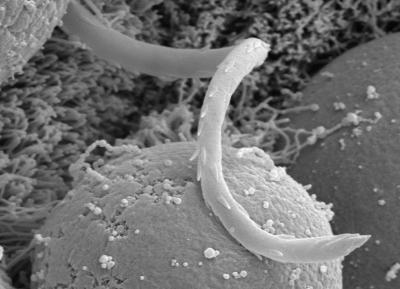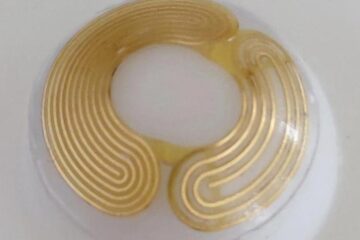Lethal parasite evolved from pond scum

The corkscrew-shaped Helicosporidium is a parasite that has its origins in green alga. Credit: Photo: Drion Boucias, University of Florida
A team led by UBC Botany Prof. Patrick Keeling sequenced the genome of Helicosporidium – an intracellular parasite that can kill juvenile blackflies, caterpillars, beetles and mosquitoes – and found it evolved from algae like another notorious pathogen: malaria.
Keeling and colleagues had previously reported that malaria shared a common evolutionary lineage with the algae responsible for toxic red tides. Their latest study, published today in the online journal PLOS Genetics, shows that Helicosporidium evolved from green alga but, unlike malaria, preserved virtually all its genes except those required for photosynthesis.
“Both malaria and Helicosporidium started out as alga and ended up as intracellular parasites preying on animals, but they have done it in very different ways,” says Keeling, director of the Centre for Microbial Diversity and Evolution at UBC and a Senior Fellow of Canadian Institute for Advanced Research.
“Malaria drastically reduced its genome and became very dependent on its host for nutrients. Helicosporidium, on the other hand, lost almost nothing except those genes required for photosynthesis, which it no longer needs as a parasite.
“It's as if photosynthesis has been surgically removed from its genome.”
The discovery, done in collaboration with scientists at the Universities of Rhode Island and Florida, will allow researchers to compare how parasites evolve at the molecular level in these two distantly related lineages.
It also provides the first insights into their origins, development as well as methods of infection, which are key to controlling the population of pest-insect hosts.
Media Contact
More Information:
http://www.ubc.caAll latest news from the category: Life Sciences and Chemistry
Articles and reports from the Life Sciences and chemistry area deal with applied and basic research into modern biology, chemistry and human medicine.
Valuable information can be found on a range of life sciences fields including bacteriology, biochemistry, bionics, bioinformatics, biophysics, biotechnology, genetics, geobotany, human biology, marine biology, microbiology, molecular biology, cellular biology, zoology, bioinorganic chemistry, microchemistry and environmental chemistry.
Newest articles

‘Smart’ contact lenses could someday enable wireless glaucoma detection
Most people with early-stage glaucoma don’t know they have it, even though early treatment is key to reducing vision loss. While detecting a subtle increase in eye pressure helps doctors…

New tech may lead to smaller, more powerful wireless devices
Good vibrations… What if your earbuds could do everything your smartphone can do already, except better? What sounds a bit like science fiction may actually not be so far off….

Caution, hot surface!
An international research team from the University of Jena and the Helmholtz Institute Jena are demystifying the mechanisms by which high-intensity laser pulses produce plasma on the surface of solids….





















